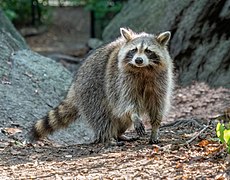Macracanthorhynchus, also known as the giant thorny-headed worm of swine, is a member of the Oligacanthorhynchidae which contains four species.
| Macracanthorhynchus | |
|---|---|
 | |
| Adult Macracanthorhynchus hirudinaceus | |
| Scientific classification | |
| Domain: | Eukaryota |
| Kingdom: | Animalia |
| Phylum: | Acanthocephala |
| Class: | Archiacanthocephala |
| Order: | Oligacanthorhynchida |
| Family: | Oligacanthorhynchidae |
| Genus: | Macracanthorhynchus Trevassos, 1917 |
| Species | |
Taxonomy
Phylogenetic analysis has been conducted on at least one of the four species in the genus, M. ingens, and confirms that this species beongs to the family Oligacanthorhynchidae.[1] The type species is M. hirudinaceus.[2]
| Archiacanthocephala |
| Phylogenetic reconstruction for select species in the class Archiacanthocephala based on a 28S rRNA gene comparison from Gomes et. al (2019) and a 18S rDNA gene comparison from Amin et al. (2020).[3][4] Amin et al. (2022) used the 18S rDNA gene and ITS1-5.8-ITS2 region of ribosomal RNA comparisons to add P. canicola phylogenetically to the family Oligacanthorhynchidae.[1] |
Description
Species
There are four species in the genus Macracanthorhynchus.[2][5][a]
- Macracanthorhynchus catulinus Kostylev, 1927
The encysted larvae of M. catulinus beetle Adesmia gebleri from the Kara Kum region are 6.32 mm long and have a proboscis 0.57 mm long with 12 longitudinal rows of three hooks each. The size of the hooks varies from 0.25 mm to 0.11 mm. Small vertebrates, such as the badger and weasel may be reservoir hosts.[6] Pre-acanthellae and acanthellae of M. catulinus were found infesting Tentyria tessulataAzerbeijan, and acanthellae were found in the paratenic hosts, Sheltopusik (Ophisaurus apodus), Coluber jugularis, Agama caucasica, Eumeces schneideri, Eremias pleskei, Lacerta strigata and the Marsh frog (Pelophylax ridibundus).[7]
- Macracanthorhynchus erinacei Dollfus, 1953
- Macracanthorhynchus hirudinaceus (Pallas, 1781)
M. hirudinaceus is a parasite which lives in the intestines of pigs and other suids, and very occasionally in humans or dogs. It causes enteritis, gastritis or peritonitis. Its life cycle includes beetles of the genus Melolontha as intermediate hosts.[citation needed] This species has many synonyms which include: Echinorhynchus gigas (Block, 1782), Macracanthorhynchus gigas (Block, 1782),[8] Echinorhynchus hirundinacea (Palas, 1781), Gigantorhynchus hirundinaceus (Pallas, 1781), Gigantorhynchus gigas (Block, 1782),[9] Hormorhynchus gigas (Block, 1782), Taenia haeruca (Pallas, 1776), and Taenia hirundinaceus (Pallas, 1781)[10] The complete mitochondrial genome of M. hirudinaceus has been sequenced.[11] The eggs have 4 membranes are 98 um long and have an elongation ratio of 1.85.[12]
- Macracanthorhynchus ingens (Linstow, 1879)
The eggs have 3 membranes are 94 um long and have an elongation ratio of 1.66.[12] It parasitizes the raccoon (Procyon lotor) in the United States.[4]
Hosts

The life cycle of an acanthocephalan consists of three stages beginning when an infective acanthor (development of an egg) is released from the intestines of the definitive host and then ingested by an arthropod, the intermediate host. The intermediate hosts of Macracanthorhynchus include beetles. When the acanthor molts, the second stage called the acanthella begins. This stage involves penetrating the wall of the mesenteron or the intestine of the intermediate host and growing. The final stage is the infective cystacanth which is the larval or juvenile state of an Acanthocephalan, differing from the adult only in size and stage of sexual development. The cystacanths within the intermediate hosts are consumed by the definitive host, usually attaching to the walls of the intestines, and as adults they reproduce sexually in the intestines. The acanthor are passed in the feces of the definitive host and the cycle repeats. There are no known paratenic hosts (hosts where parasites infest but do not undergo larval development or sexual reproduction) for Macracanthorhynchus.[14]
- Hosts for Macracanthorhynchus
- The Racoon is a host of M. ingens
